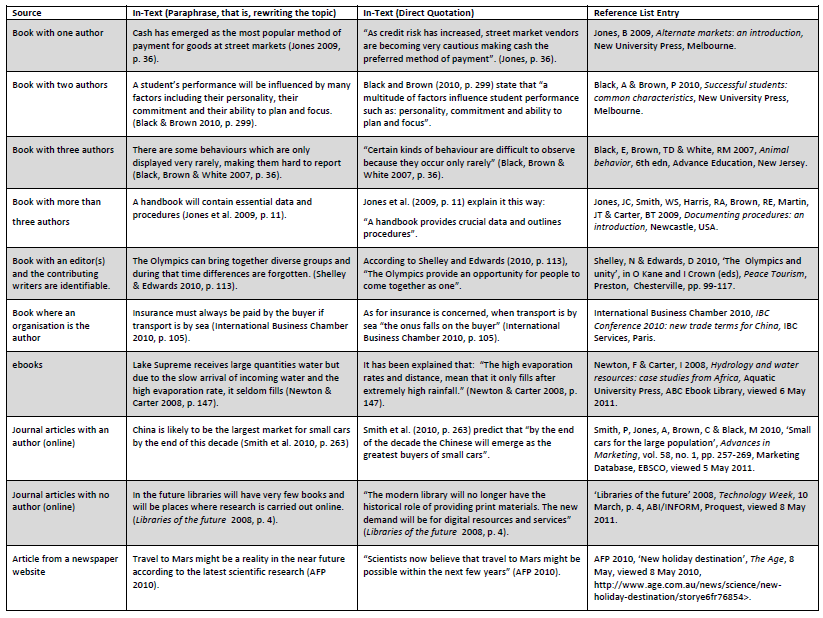GUIDE TO ACADEMIC REFERENCING
Harvard Referencing Style is a convention of academic writing that students must follow for several reasons, including:
acknowledging the ideas, information, and words of others;
enabling readers to judge your understanding and use of existing knowledge;
avoiding accusations of plagiarism.
It is essential that students use a standard referencing style in their assignments – Holmes Institute uses the Harvard Referencing Style.
There are two parts to Harvard Referencing Style:
in-text citations – In-text citations are used within your assignments whenever you use information from a source.
list of references – for all assignments lecturers require a list of references rather than a bibliography – A reference list is usually the last page of your written assignment and is the list of sources that you have cited in your assignment (but before any appendixes you might include).
In-text citations for Harvard Referencing Style
When you paraphrase or quote, always include the page number or page numbers in the in-text reference, placed after the year it was published.
If you quote, enclose the text in double quotation marks: “ ”.
If you quote more than one sentence, don’t use double quotation marks around the quotation – instead, place the quotation on a new line and indent it from the left margin.
If an information source doesn’t have an author, the author detail is replaced by the title and is italicised.
Unless a writer uses language that is particularly apt, it is a good idea to paraphrase – put the material into your own words – whenever you can. This shows that you are able to synthesise the ideas rather than merely repeat them.
Examples are located in the table at the end of this document.
Reference List
The reference list should be in alphabetical order using either the author’s surname or the names of the authoring bodies.
The titles are used if the author’s name is not known.
The different details, or elements, of each citation are separated by commas. The whole citation finishes with a full stop.
Examples are located in the table at the end of this document.
Books: The details you must include in the entry are as follows and must be presented in this order:
1. Author(s) – either a person(s) or an organisation – or editor(s). Surname first, initial(s) next. No full stops or spaces are used between initials.
2. Year of publication.
3. Title – plus the subtitle, if there is one. Place a colon between the title and subtitle – both in italics; minimal capitalisation.
4. Title of series and volume number, if applicable.
5. Edition – only if this is not the first edition of the book. Edition is abbreviated to ‘edn’.
6. Publisher.
7. Place of publication.
Articles from journals found in library databases: The details and order required are:
1. Author(s).
2. Year of publication.
3. Title of article – enclose in single quotation marks.
4. Title of journal – in italics, maximal capitisation.
5. Volume and/or issue number. Volume number is given a prefix of ‘vol.’, issue number a prefix of ‘no.’.
1. 6.. Page number(s), if they are included. Use the abbreviations p. for a single page, and pp. for a page range, eg pp. 11-12
6. Title of the database.
7. Date that you first viewed the online resource (day, month and year). Precede the date with the word ‘viewed’.
Information from the web: Include as many of the following details in the entry as possible:
1. Author(s), editor(s), compiler(s) or organisation responsible for the website – if given.
1. If there is no clearly identifiable author, do not use the name of the Copyright owner. If there is no author, use the title, in italics.
2. Year the information was created or year of the most recent revision, modification or update. Use the Copyright date of a webpage if there is no date of creation.
3. If a range of dates is given, use the latest date.
4. Title of document.
5. Name of the organisation hosting the webpage on their website.
6. Date that you first viewed the webpage (day, month and year). Precede the date with the word ‘viewed’.
7. URL. The URL (website address) should be enclosed in angle brackets: < > .
Harvard Referencing Style Tabular Form:
ORDER YOUR ASSIGNMENT TO GET PERFECT Harvard Referencing Style.




